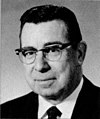Francis C. Turner 1969–1972

Francis C. Turner, during his lifelong career with the Bureau of Public Roads, won national and international acclaim for his contributions to both national and international highway programs.
He joined the Bureau of Public Roads in 1929 as a junior highway engineer and began a steady rise through the ranks.
Fourteen years later he had acquired such stature that he was detailed (1943-1946) to Alaska as adviser on maintenance of the Alaska Highway.
In the next 4 years (1946-1950) he served with distinction as coordinator of the entire Philippine Rehabilitation Program.
Subsequent to this assignment, he held several top positions with the Bureau of Public Roads: Deputy Commissioner, Chief Engineer, Assistant Federal Highway Administrator, and Director of the Bureau of Public Roads. Furthermore, he was a member of the task force that set up the Department of Transportation.
He was named Federal Highway Administrator on February 24, 1969.
During his tenure as Federal Highway Administrator, new attention was given to the environment, accelerated concern was focused on highway safety, and increased emphasis was placed on the quality of life for people affected by highway construction.
Norbert T. Tiemann 1973–

Norbert T. Tiemann, former Governor of Nebraska, is the current Federal Highway Administrator.
Governor Tiemann’s term as Nebraska’s Chief Executive, from 1967 to 1971, included several major accomplishments on behalf of his State. Among these were:
- First broad reorganization of the Department of Roads.
- First revenue bonds for highway construction.
- Closing of the Omaha Gap on Interstate 80.
- Established the first 20-year plan for construction of a comprehensive expressway-freeway system.
- First mandatory driver examination.
- First motor-vehicle inspection program.
After completing his term as Governor, he served as Vice President for Corporate Finance of First Mid-America, Inc., an investment banking firm in Lincoln.
In his position as Administrator, he was involved in the obligation of $7.8 billion in Federal-aid highway funds in fiscal year 1975—the largest amount in the history of the Federal-State highway program.
Other accomplishments have included the close planning liaison between FHWA and the Urban Mass Transportation Administration and the conclusion of an agreement with Iran for FHWA personnel to advise and assist that country in building a modern highway network.
195
